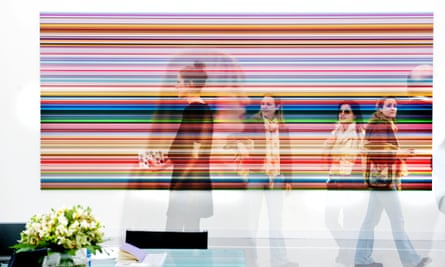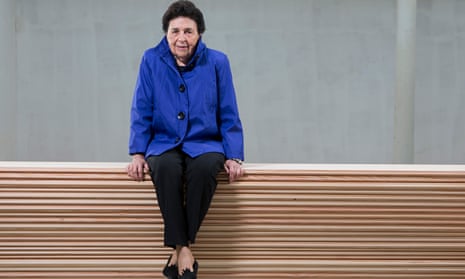Marian Goodman does not look like one of the most powerful figures in the contemporary art world. When she walks into the building site that will become her new gallery space just off Golden Square, in London’s Soho, she is dwarfed by scaffolding. She is tiny – barely 5ft tall – dressed all in black, and when she speaks, her voice is so soft that the architects in hard hats have to crane down to hear what she is saying.
But Goodman, aged 86, has been operating at the pinnacle of the art industry for over half a century. As a gallerist, she was one of the first to introduce key European artists such as Gerhard Richter, Joseph Beuys and Marcel Broodthaers to American audiences and has represented some of the biggest names in the business, including Anselm Kiefer, the sculptor Richard Deacon and the video artist and Oscar-winning film director Steve McQueen.
This is the New Yorker’s first foray into the London art scene and it has been greeted with a frisson of anticipation. The Marian Goodman Gallery opens this week with an exhibition of Richter works.
“The whole thing is surreal,” Goodman says in an almost whisper, her words lost in the hammering and drilling. She shakes her head and smiles. The general impression is that of a kindly grandmother, watching on proudly as her cake rises in the oven.
But it would be wrong to underestimate her. This is the woman who as an up-and-coming New York gallerist in the early 1980s came across Richter’s work, decided she simply had to represent him and wrote to him insisting they must meet.
“He was a bit drowned out by all these loud, expressionist voices,” Goodman recalls. “So I wrote him a letter just telling him how much I loved the work and maybe I could make a difference. Then I went to meet him in Düsseldorf in 1984 and everything started from there.”
Richter’s work is now the world’s most expensive for a living artist – he set a record with the sale of a $34.2m (£21.3m) painting in 2012, only to smash it again at auction last year for a 1968 work that fetched $37m (£24m).
Is she surprised by the prices his work commands?
“Yes,” she says calmly. “I’m surprised and so is he.”

Goodman’s eye for art was inherited from her father, Maurice, a first-generation Hungarian-American accountant who collected art in his spare time. Maurice would mount impromptu exhibitions for his two children in the family’s apartment near Central Park, covering the walls with posters and reproductions cut from books and magazines. He had a particular taste for Milton Avery, who became a friend, and for the folk artist Grandma Moses.
“I thought he was mad,” says Goodman. “The Grandma Moses paintings looked to me as if they’d been done by a 10-year-old.”
Living in the same apartment block was the art dealer Sidney Janis. One of Goodman’s earliest memories is of playing with Janis’s children in front of a big jungle canvas painted by Henri Rousseau, entitled The Dream (it is now in the Museum of Modern Art in New York). “I remember we played this game in front of the canvas where we pretended we were going to enter the jungle,” says Goodman, chuckling. “I just got to fall in love with art.”
She married at 21 to a civil engineer and the couple had two children (her son, Michael, is a photographer; her daughter, Amy, a herbalist). The relationship didn’t last and, as a newly divorced single mother, she turned to art to make a living, enrolling for an art history PhD at Columbia University and, later, setting up a small publishing initiative specialising in artists’ prints, funded by $5,000 from the sale of a Milton Avery her father had given her.
It was the 1960s in New York. The art world was buzzing. She rubbed shoulders with Andy Warhol, whom she remembers being “so quiet and hyper-shy”.
In 1968, she went to Documenta, an international art show in Germany, and was bowled over by the freshness and originality of the work on display by a new generation of artists seeking to come to terms with their nation’s past.
“It changed everything for me,” Goodman says. “I saw Joseph Beuys’s work for the first time... I tried to get one of the curators at Moma to be interested in it and I had such a rejection! As I got to know the work better, I felt I should represent it in New York.”

And, just like that, she set up a gallery on West 57th Street that would become one of the most influential in the world. Talking about it now, Goodman makes it sound easy, but the art industry was a male-dominated environment. She won’t dwell on this, other than to call it “sexist” and to recount an unpleasant incident when she first opened her doors and a male gallerist paid her a visit and said: “You know, I’m going to bury you.”
That must have been scary, I say.
“Well, it’s not nice to know you have an enemy you didn’t do anything to deserve,” she replies. “In some ways, though, I think it may be easier for a woman. It’s a mixed bag but I think women are maybe more attuned to the qualities that a gallerist needs in a relationship with her client.”
In fact, Goodman is famed for her nurturing approach. She compares representing artists to “tending a garden” and spends three or four hours on the phone every day talking to them. One of her artists, the photographer Jeff Wall, describes being represented by Marian Goodman as like being in a marriage. “But I’ve got about 20 other marriages too!” she insists.
She chooses an artist on the basis of “originality and talent”.
“But it’s also about the nature of each artist’s work… I think it has to show an involvement with life, the focus of which is bigger than one’s navel.”
She is particularly good at spotting new talent and, once she has done so, she commits to working with an artist for 15-20 years. She discovered the German artist Lothar Baumgarten when she hired him to hang the gallery’s display at a Düsseldorf art fair.
“He told me, very modestly, he was an artist and he had a show on of his work at the time. So I went to see it and I thought the work was fantastic.”
She is as astonished as anyone that she has an eye for great art. It’s an instinct, Goodman says, and not one she can properly put into words. But she has an abiding horror of the mob mentality – a legacy, perhaps, of her progressive education at New York’s the Little Red School House (one of the first ethnically diverse schools in the city), and her Jewish, immigrant heritage. When, in the 1980s, all the major New York galleries moved en masse to Soho, Goodman stayed put. She represented cerebral Europeans at a time when everyone else in New York was showing big American names. These days, in an era when uber-gallerists have become celebrities in their own right, Goodman stays determinedly out of the spotlight. She gives few interviews and hates being the centre of attention. Why?
“Well, I think the credit belongs to the artist,” she says, as if it is the most obvious thing in the world.

Comments (…)
Sign in or create your Guardian account to join the discussion